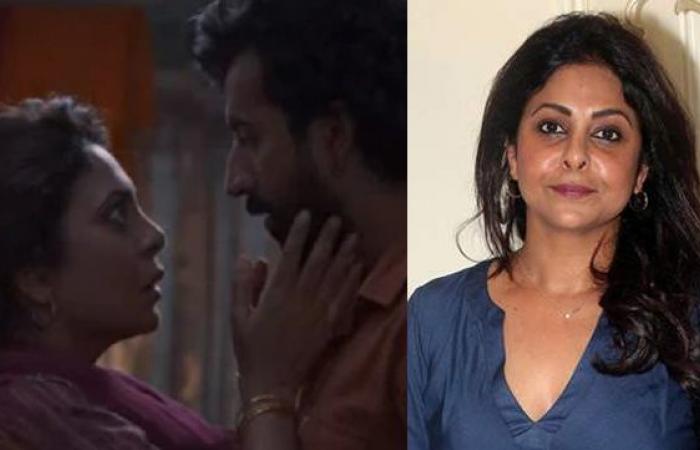Remember Akshay Kumar , Rekha, and Raveena Tandon starrer 1996 action thriller Khiladiyon Ka Khiladi ? In this Umesh Mehra directorial, Kumar and Tandon were the romantic leads. Rekha and Kumar’s thirsty track was only meant to titillate moviegoers and add a bit of sauce and steam to the film. Even by looking at the movie’s posters, you could gauge its intention—it didn’t want you to take Kumar and Rekha’s pairing seriously or think that something could become of it. But Khiladiyon Ka Khiladi is too dated. Let’s look at Ae Dil Hai Mushkil, which released six years ago. Much was made of Ranbir Kapoor and Aishwarya Rai Bachchan’s on-screen chemistry. It was a huge part of the marketing strategy of Dharma Productions, which blew it out of proportion just to get people talking. Bachchan and Kapoor shot for magazine covers, all sexy and smouldering, stoking people’s interest. But even before the Karan Johar film was released, it was amply clear that Anushka Sharma, and not Bachchan, is the female lead, the woman our hero is hopelessly in love with. Older women-younger men romances have always suffered stigma in Hindi films. The gaze with which filmmakers chose to look at them has almost always been non-serious, if not out rightly flippant or derogatory. They saw them as a ploy, a side to add a bit of oomph and spice to their otherwise bland serving. They loved to milk it but also never failed to pass moral judgment and tell you off by the way they cooked it on screen. Khiladiyon Ka Khiladi and Ae Dil Hai Mushkil are just two popular examples. The waters run deep. Fortunately, the advent of streaming in India has forever changed the grammar of moviemaking and what’s acceptable on screen. In the last seven years, the way we consume cinema has transformed irrevocably, forcing filmmakers to rethink, discard jaded ideas of morality, and recalibrate according to current sensibilities and syntax. Now older women-younger men romance and the exploration of aging women’s sexuality are no longer taboo—reduced to and presented as trashy thirst traps. They are given the dignity they deserve, treated as any other living, breathing love story, and made with a lot of thought, heart, and care. In fact, the sexuality of older women, which was painfully invisible on screen thus far, is finding space and being portrayed in all its complexity with heart-warming sensitivity and nuance in an increasing number of films and shows. The recent examples are many and morale-boosting. Alankrita Srivastava’s films Lipstick Under My Burkha and Dolly Kitty Aur Woh Chamakte Sitare, My Beautiful Wrinkles—a wonderful short headlined by Sarika from Amazon Prime Video’s recent anthology series Modern Love Mumbai, Konkona Sen Sharma’s directorial debut A Death in the Gunj, Mira Nair’s A Suitable Boy, and now Jasmeet K Reen’s Darlings. It’s not a coincidence that all these films and series have been made by women. Because no man, no matter how gifted, can never translate on screen the lived experience of being a woman. The poignancy. The hunger. The fire. The ache. The judgment. The stigma. The unfairness of it all. It takes a woman to tell our stories the way they need to be told. If you look at it, the track of Shutu (a beautiful, brilliant Vikrant Massey) and Mimi (Kalki Koechlin) in A Death in the Gunj or Dolly ( Konkona Sen Sharma ) and Osman (Amol Parashar) in Dolly Kitty Aur Woh Chamakte Sitare , or Shamsunissa ( Shefali Shah ) and Zulfi (Roshan Mathew) in Darlings are not central to their films. But remove them and these movies will not be the same. You may like Nair’s A Suitable Boy or may find it too sprawling, but there is no denying that the subliminal love story of courtesan Saeeda Bai (an effervescent Tabu) and Maan Kapoor (Ishaan Khatter) eclipses everything else in the gorgeous period drama. Similarly, Lipstick Under My Burkha would have lost its throbbing heart if Rosy Buaji’s (Ratna Pathak Shah) story were left out. Desire—sexual or otherwise—doesn’t disappear in women with age; it only matures. To completely negate it in cinema, which borrows heavily from our social, political, and cultural mores, is to make invisible an important section of our people and create an insurmountable chasm around it. The surest way to kill something is to not pay it any attention. To mock it or present it in bad taste or crude light is even worse; it’s irresponsible. We sure have come a long way since Khiladiyon Ka Khiladi. But there is much farther to go. The more we include aging women’s sexuality in our films and shows, the more we look at it with a gaze that’s nuanced and sensitive, the more we will normalize it and make it a part of cultural conversation. When not reading books or watching films, Sneha Bengani writes about them. She tweets at @benganiwrites. Read all the Latest News , Trending News , Cricket News , Bollywood News , India News and Entertainment News here. Follow us on Facebook , Twitter and Instagram .
Let’s Talk About Women | Hindi films and streaming are beginning to see older women’s sexuality
Sneha Bengani
• August 29, 2022, 13:23:08 IST
The advent of streaming in India has forever changed the grammar of moviemaking and what’s acceptable on screen. Older women-younger men romance and the exploration of aging women’s sexuality are no longer reduced to and presented as trashy thirst traps. They are given the dignity they deserve.
Advertisement
)
End of Article